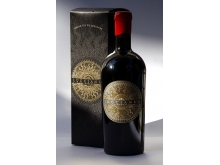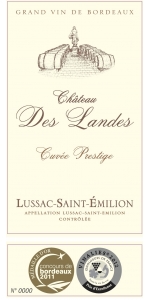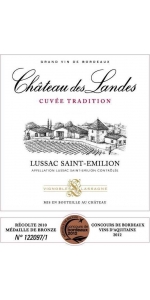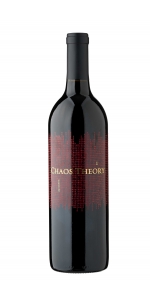Luccianus Amphore Lussac St. Emilion 2022
6 bottles with free shipping for: $300.00
12 bottles with free shipping for: $540.00
| BUY MORE! SAVE MORE! | ||||||||||||||||||||
|
| Country: | France |
| Region: | Bordeaux |
| Winery: | Chateau des Landes |
| Grape Type: | Cabernet Franc |
| Organic: | Yes |
| Vintage: | 2022 |
| Bottle Size: | 750 ml |
Luccianus Amphore Lussac St. Emilion is made from 100% Cabernet Franc.
Luccianus is the name of Gallo-Roman origin designating the town of Lussac and its vineyard dating from the 4th century. This 100% Cabernet Franc is produced from the estate oldest vines of 100 years of age and is a return to ancestral aging techniques. The amphora aging gives out a very expressive wine with a superb aromatic radiance and very silky tannins all without a woody note.
The wine shows a beautiful deep purple color. The nose is complex and rich with intense notes of fruits and spices. The palate is round and powerful with silky tannins.
Chateau des Lande Estate
Château des Landes was created in 1952 by Paul Lassagne, Nicolas' grandfather. He started with only 2 hectares and grew to 7 hectares in 1979.
His son, Daniel, came along and bought more vineyards surrounding the cellar and he managed to grow to 27 hectares in almost 20 years.
In 2001, Nicolas, came aboard and decided to continue on the family tradition bringing his expertise and his knowledge.
Nicolas is now in charge of the Estate and he manage 27.2 hecatres of vineyards (68 hectares).
Chateau de Landes Vineyard
27.2 hectares (68 acres) of vineyard with a density of 5,500 vineplants per hecatres ( 2,217 vineplants per acre).
The average age of the vine is 30 years.
The soil is mostly a mix of Clay and limestone, while the subsoil is white clay.
Landes Cuvee Prestige Lussac Saint Emilion is made from 80% Merlot, 15% Cabernet Sauvignon and 5% Cabernet Franc
Color: deep dark ruby intense color
Aroma: racy and aromatic nose with aromas of ripe red fruit, floral notes, wood and spice with a touch of vanilla.
Taste: this wine has a good structure and some powerful aromas of raspberries, blackcurrant, vanilla and it is powerful with a complex finish. The oak is present but not dominant. The tannins are quite well integrated already.
Average age of the Vines: 60 years Yield : 50 hectoliters / hectare. Grape picking: harvest by machine. Vats: Stainless steel thermoregulated and computerized. Fermentation: 45 to 50 days with a final 35°C warm steeping. Winemaking: Malolactic fermentation in new oak barrel. Ageing: 16 months in new French Oak barrels from Allier and Limousin. Annual production: 10,000 bottles. (833 cases)
Review:
"This shows aromas of ripe blackcurrants and blackberries with walnuts, spices and cocoa. Medium-bodied with firm tannins and a bright, succulent character. Racy finish. Drink or hold."
- James Suckling (December 2022), 92 pts
Landes Cuvee Tradition Lussac Saint Emilion is made from 80% Merlot, 15% Cabernet Sauvignon and 5% Cabernet Franc
Color: deep ruby intense color.
Aroma: racy and aromatic nose with aromas of ripe red fruit.
Taste: this wine is silky, round and smooth first taste, with aromas of raspberries, and blackcurrant, powerful and complex finish.
Brown Estate Chaos Theory is made from 37% Cabernet Franc 21% Cabernet Sauvignon 21% Zinfandel, 13% Merlot 8% Barbera
Dark garnet core, ruby rim. Maraschino cherry, red licorice, effervescent citrus, rose garden, chamomile blossom, Italian leather, and creme de cassis followed by cardamom, clove, cinnamon, churned cream, fresh vanilla, and a touch of graphite. Full body with juicy, creamy mouthfeel and supple tannins.
Reviews:
Mulberry, heather, and sarsaparilla are uniquely joined in this plush blend of Cabernet Franc, Cabernet Sauvignon, and Zinfandel. Notes of cardamom, cinnamon stick, chocolate-raspberry cake are dreamy. Vivid acid structure is within a frame of spiced, dried spring flowers and plum liqueur.
-Tasting Panel 93 Points
This concentrated Merlot-Zinfandel-Petite Sirah blend brings waves of cherry gastrique, raspberry liqueur, violets and caramel on the nose, while the palate leans into ripe blueberries, dark chocolate and raspberry coulis with expansive texture and velvety tannins.
-Wine Enthusiast 93 Points
Landes Cuvee Tradition Lussac Saint Emilion is made from 80% Merlot, 15% Cabernet Sauvignon and 5% Cabernet Franc
Color: deep ruby intense color.
Aroma: racy and aromatic nose with aromas of ripe red fruit.
Taste: this wine is silky, round and smooth first taste, with aromas of raspberries, and blackcurrant, powerful and complex finish.
Landes Cuvee Tradition Lussac Saint Emilion is made from 80% Merlot, 15% Cabernet Sauvignon and 5% Cabernet Franc
Color: deep ruby intense color.
Aroma: racy and aromatic nose with aromas of ripe red fruit.
Taste: this wine is silky, round and smooth first taste, with aromas of raspberries, and blackcurrant, powerful and complex finish.
Landes Cuvee Tradition Lussac Saint Emilion is made from 80% Merlot, 15% Cabernet Sauvignon and 5% Cabernet Franc
Color: deep ruby intense color.
Aroma: racy and aromatic nose with aromas of ripe red fruit.
Taste: this wine is silky, round and smooth first taste, with aromas of raspberries, and blackcurrant, powerful and complex finish.
- back
Viejo Isaias Juana Cabernet Franc is made from 100 percent Cabernet Franc.
Cabernet Franc has an intense bright velvety red color. In the nose this wine reveals a complex expression marked by fresh berries followed by hints of floral aromas. It also displays some smoke and vanilla from the oak barrels. It is rich and balanced in the mouth with an elegant tannic structure and long fresh fruit end.
Vineyard information:
Location: Perdriel, Luján de Cuyo, on the highest area of the Mendoza river - Mendoza.
Altitude: 950m above sea level.
Soil: Stony, from Alluvial origins
Coming from our estate vineyards in Perdriel and Lujan de Cuyo.
Aged in 50% French and 50% American Oak barrels for 12 months. First and second use only.
Wine was slightly filtered before bottling.
Excellent when paired with red meats, pasta with spicy sauces, matured cheeses.
Review:
"Hints of plums and dark berries with some dried flowers, following through to a medium body with round tannins and a juicy finish. Bigger in nature. Drink or hold."
- James Suckling (March 2022), 92 pts
100% apple wine. A blend of Golden Delicious and Fuji apples hand-picked in the Shenandoah Valley; aromas and flavors of freshly harvested apples, blossoms and spices. (semisweet)








